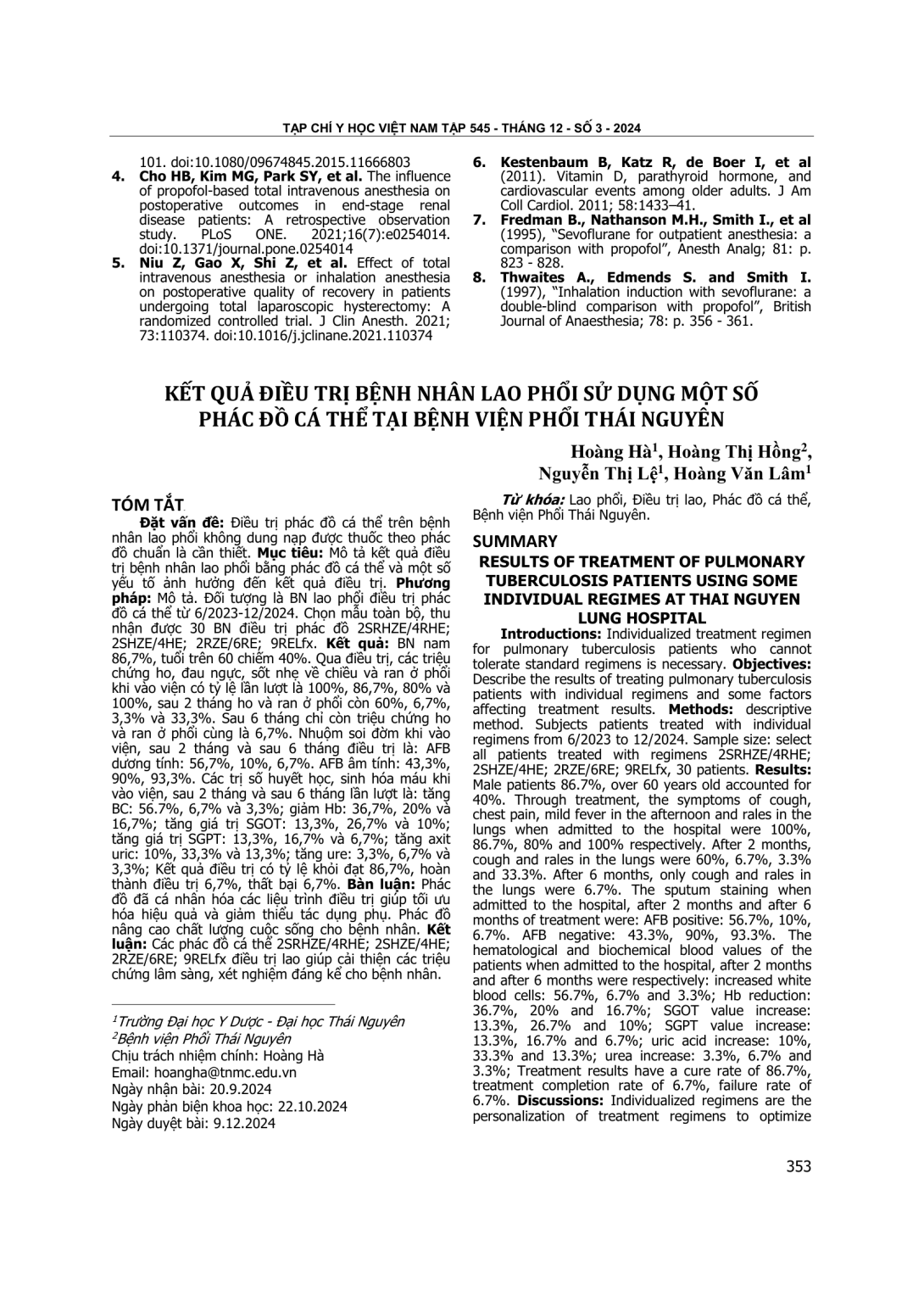
Điều trị phác đồ cá thể trên bệnh nhân lao phổi không dung nạp được thuốc theo phác đồ chuẩn là cần thiết. Mục tiêu: Mô tả kết quả điều trị bệnh nhân lao phổi bằng phác đồ cá thể và một số yếu tố ảnh hưởng đến kết quả điều trị. Phương pháp: Mô tả. Đối tượng là BN lao phổi điều trị phác đồ cá thể từ 6/2023-12/2024. Chọn mẫu toàn bộ, thu nhận được 30 BN điều trị phác đồ 2SRHZE/4RHE; 2SHZE/4HE; 2RZE/6RE; 9RELfx. Kết quả: BN nam 86,7%, tuổi trên 60 chiếm 40%. Qua điều trị, các triệu chứng ho, đau ngực, sốt nhẹ về chiều và ran ở phổi khi vào viện có tỷ lệ lần lượt là 100%, 86,7%, 80% và 100%, sau 2 tháng ho và ran ở phổi còn 60%, 6,7%, 3,3% và 33,3%. Sau 6 tháng chỉ còn triệu chứng ho và ran ở phổi cùng là 6,7%. Nhuộm soi đờm khi vào viện, sau 2 tháng và sau 6 tháng điều trị là: AFB dương tính: 56,7%, 10%, 6,7%. AFB âm tính: 43,3%, 90%, 93,3%. Các trị số huyết học, sinh hóa máu khi vào viện, sau 2 tháng và sau 6 tháng lần lượt là: tăng BC: 56.7%, 6,7% và 3,3%; giảm Hb: 36,7%, 20% và 16,7%; tăng giá trị SGOT: 13,3%, 26,7% và 10%; tăng giá trị SGPT: 13,3%, 16,7% và 6,7%; tăng axit uric: 10%, 33,3% và 13,3%; tăng ure: 3,3%, 6,7% và 3,3%; Kết quả điều trị có tỷ lệ khỏi đạt 86,7%, hoàn thành điều trị 6,7%, thất bại 6,7%. Bàn luận: Phác đồ đã cá nhân hóa các liệu trình điều trị giúp tối ưu hóa hiệu quả và giảm thiểu tác dụng phụ. Phác đồ nâng cao chất lượng cuộc sống cho bệnh nhân. Kết luận: Các phác đồ cá thể 2SRHZE/4RHE; 2SHZE/4HE; 2RZE/6RE; 9RELfx điều trị lao giúp cải thiện các triệu chứng lâm sàng, xét nghiệm đáng kể cho bệnh nhân.
Individualized treatment regimen for pulmonary tuberculosis patients who cannot tolerate standard regimens is necessary. Objectives: Describe the results of treating pulmonary tuberculosis patients with individual regimens and some factors affecting treatment results. Methods: descriptive method. Subjects patients treated with individual regimens from 6/2023 to 12/2024. Sample size: select all patients treated with regimens 2SRHZE/4RHE; 2SHZE/4HE; 2RZE/6RE; 9RELfx, 30 patients. Results: Male patients 86.7%, over 60 years old accounted for 40%. Through treatment, the symptoms of cough, chest pain, mild fever in the afternoon and rales in the lungs when admitted to the hospital were 100%, 86.7%, 80% and 100% respectively. After 2 months, cough and rales in the lungs were 60%, 6.7%, 3.3% and 33.3%. After 6 months, only cough and rales in the lungs were 6.7%. The sputum staining when admitted to the hospital, after 2 months and after 6 months of treatment were: AFB positive: 56.7%, 10%, 6.7%. AFB negative: 43.3%, 90%, 93.3%. The hematological and biochemical blood values of the patients when admitted to the hospital, after 2 months and after 6 months were respectively: increased white blood cells: 56.7%, 6.7% and 3.3%; Hb reduction: 36.7%, 20% and 16.7%; SGOT value increase: 13.3%, 26.7% and 10%; SGPT value increase: 13.3%, 16.7% and 6.7%; uric acid increase: 10%, 33.3% and 13.3%; urea increase: 3.3%, 6.7% and 3.3%; Treatment results have a cure rate of 86.7%, treatment completion rate of 6.7%, failure rate of 6.7%. Discussions: Individualized regimens are the personalization of treatment regimens to optimize effectiveness and minimize side effects for each specific patient. Individualized regimens help keeping enhance the quality of life for patients. Conclusions: Individualized regimens 2SRHZE/4RHE; 2SHZE/4HE; 2RZE/6RE; 9RELfx tuberculosis treatment helps improve clinical symptoms and laboratory tests significantly for patients.
- Đăng nhập để gửi ý kiến
